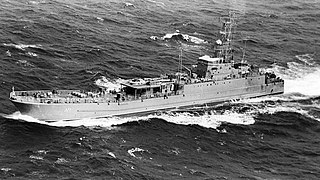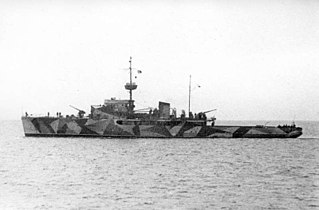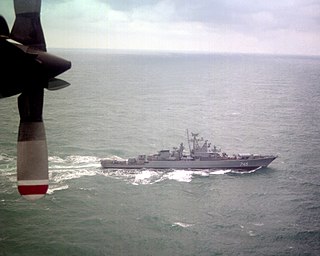
The Finnish Navy is one of the branches of the Finnish Defence Forces. The navy employs 2,300 people and about 4,300 conscripts are trained each year. Finnish Navy vessels are given the ship prefix "FNS", short for "Finnish Navy ship", but this is not used in Finnish language contexts. The Finnish Navy also includes coastal forces and coastal artillery.

The Soviet Navy was the naval warfare uniform service branch of the Soviet Armed Forces. Often referred to as the Red Fleet, the Soviet Navy made up a large part of the Soviet Union's strategic planning in the event of a conflict with the opposing superpower, the United States, during the Cold War period between the two countries. The Soviet Navy played a large role during the Cold War (1945-1991), either confronting the North Atlantic Treaty Organisation in western Europe or power projection to maintain its sphere of influence in eastern Europe.

Rubin Central Design Bureau for Marine Engineering in Saint Petersburg is one of three main Russian centers of submarine design, and the other two are Malakhit Marine Engineering Bureau and Lazurit Central Design Bureau. Rubin is the largest among the three Soviet/Russian submarine designer centers, having designed more than two-thirds of all nuclear submarines in the Russian Navy. "Rubin" is the Russian word for ruby.

The Zubr class is a class of Soviet-designed air-cushioned landing craft (LCAC). The name "Żubr" is Polish for the European bison. This class of military hovercraft is, as of 2012, the world's largest, with a standard full load displacement of 555 tons. The hovercraft was designed to sealift amphibious assault units from equipped/non-equipped vessels to non-equipped shores, as well as to transport and plant naval mines.

The Polnocny -class ships are amphibious warfare vessels. They were designed in Poland, in cooperation with the Soviet Navy and were built in Poland between 1967 and 2002. They now serve in several different navies, and some have been converted to civilian use. The name comes from the Stocznia Północna shipyard at Gdańsk, where they were built. 107 were built by 1986. In 2002, one ship of a modernised design NS-722 was built in Gdynia for Yemen.

The Black Sea Shipyard is a shipbuilding structure located in Mykolaiv, Ukraine. It was founded in 1895 by Belgian interests and began building warships in 1901. At the beginning of World War I in 1914, it was one of the largest industrial facilities in the Russian Empire. The shipyard was moribund until the Soviets began building up the fleet in the 1930s and it began building surface warships as well as submarines. The yard was badly damaged during World War II and took several years to be rebuilt. Surface warship construction temporarily ended in the mid-1950s before being revived in the mid-1960s and submarines were last built in the yard in late 1950s. The Black Sea Shipyard built all of the aircraft carrying ships of the USSR and Russia and continues to build large commercial ships.

The M class were the standard minesweeper of Nazi Germany's Kriegsmarine during World War II. The vessels were the primary force in Germany's harbor defense command and were organized administratively into minesweeper flotillas.

The Yevgenya class are a series of minesweepers built for the Soviet Navy and export customers between 1967 and 1980. The Soviet designation was Project 1258 Korund.
Project 1252 'Izmrud' were a group of three minesweepers built for the Soviet Navy in the late 1960s. The ships were a glass-reinforced plastic (GRP)-hulled version of the preceding wooden-hulled Vanya class. They were intended to be a prototype of an advanced design, instead the Soviet Navy returned to wooden-hulled minesweeper construction with the following Sonya class. Of the three minesweepers, one was lost in an explosion in 1989 and the fate of the other two is unknown.

The Polish Navy is a military branch of the Polish Armed Forces responsible for naval operations. The Polish Navy consists of 48 ships and about 12,000 commissioned and enlisted personnel. The traditional ship prefix in the Polish Navy is ORP.

The Boris Chilikin class also known as Project 1559V Morskoy prostor is a series of fleet replenishment oilers built in 1970s for the Soviet Navy and currently in service with the Russian Navy.

NMS Amiral Murgescu was a minelayer and convoy escort of the Romanian Navy, the first sea-going warship built in Romania and the largest Romanian-built warship of World War II. She laid numerous minefields, from the Bulgarian port of Burgas to the Crimean port of Sevastopol, which inflicted significant losses to the Soviet Black Sea Fleet. She also carried out numerous convoy escort missions and took part in the Axis evacuation of the Crimea in May 1944. Due to her success in combat, she was decorated twice by May 1944. She was captured by the Soviet Union in September 1944 and served until 1988, when she was scrapped.

The Fugas class were a group of minesweepers built for the Soviet Navy in the 1930s and 1940s. The Soviet designations were Project 3, Project 53, Project 53-U and Project 58.

Bditel'nyy or Bditelnyy was a Project 1135 Burevestnik Large Anti-Submarine Ship or Krivak-class frigate that served with the Soviet and Russian Navies. Launched on 28 March 1970, the vessel served as part of the Baltic Fleet but operated more widely than the Baltic Sea, demonstrating the emerging blue water capability of the Navy. A dedicated anti-submarine vessel, with an armament built around the Metel system, the ship spent the period between 26 December 1970 and 30 September 1971 undertaking trials and tests to prove the new systems. During that time General Secretary Leonid Brezhnev and Admiral of the Fleet Sergey Gorshkov were both hosted on board. The vessel then subsequently undertook tracking of submarines in the Baltic, Black and Mediterranean Seas, and even travelled as far as Cuba, crossing the Atlantic Ocean. The ship also visited friendly ports like Annaba in Algeria, Gdynia in Poland and Rostock in East Germany. With the end of the Cold War, the ship also travelled to Belgium and visited Antwerp. During June 1993, Bditelnyy took part in BALTOPS-93, the first joint exercise between NATO and Russia. However, soon afterwards, the ship was retired and, on 31 July 1996, decommissioned and subsequently broken up.
During the Second World War, the Royal Romanian Navy operated a total of 9 submarines: three fleet submarines and six midget submarines. These vessels fought on the Axis side during the war. Only two of them survived the war and continued to serve in the Romanian Navy until the 1960s.
The Project 23900 Ivan Rogov is the newest class of Russian amphibious assault ships (LHDs) intended as a replacement for the French Mistral class, two of which were ordered by Russia in 2011, but that France refused to deliver in September 2014 due to Russia's military intervention in Ukraine. A contract was signed on 22 May 2020 for the construction of two Project 23900 LHDs with a displacement of 40,000 tons. The construction is led by JSC Zelenodolsk Design Bureau, which is a part of JSC Ak Bars Shipbuilding Corporation, and the first vessel should be launched by 2023 and commissioned by 2025.

Already in the 9th century, Kievan Rus' had the powerful naval fleet which is proved by the successful naval Siege of Constantinople of 860 However the naval fleet was irregular and was built only for the purpose of raids. Due to several major weakness of the naval fleet and in addition destructive invasion by the Mongol Empire, later the irregular naval fleet of the Kievan Rus principalities was dissolved. Except for the Principality of Novgorod which had access to the open seas and also was saved from Mongol invasions. In the 14th century, raids by Novgorod pirates, or ushkuiniki, sowed fear as far as Kazan and Astrakhan. As the first and proper Russian state of the Grand Duchy of Moscow begun and also got access to open water bodies, the Golden Age of the Russian Navy began. In 1570, in order to protect Russian navigation at the Baltic Sea, Ivan the Terrible created a flotilla which existed for about a year. In the 16th century, the Tsardom of Russia fought against the Ottoman Empire to get free access to the Black Sea.

SMS M68 was a M1916 type minesweeper built for the Imperial German Navy during the First World War. She entered service on 6 October 1917, but was mined and sunk off Latvia on 29 October 1917. The ship was salvaged by Latvia and entered service with the Latvian Navy on 10 November 1921 under the name Virsatis. She was taken over by the Soviet Navy in August 1940 when the Soviet Union occupied Latvia in August 1940, serving as T-297 and was sunk by a mine on 2 December 1941.

Svirepyy was a Project 1135 Burevestnik-class Large Anti-Submarine Ship or Krivak-class frigate that served with the Soviet Navy. Displacing 3,200 tonnes full load, the vessel was built around the Metel anti-submarine missile system. The ship was launched on 27 January 1971 in Kaliningrad and joined the Baltic Fleet. The ship's service was not restricted to the Baltic Sea and instead travelled widely, visiting a number of foreign friendly ports during the next two decades, including Gdynia, Poland and Havana, Cuba. Svirepyy was designated a Guard Ship from 1977 as Soviet strategy changed to one creating safe areas for friendly submarines close to the coast. However, the ship continued to travel widely, including trips to the capital cities of both Finland and Tunisia as well as Rostock in East Germany. Svirepyy was transferred to the Russian Navy after the dissolution of the Soviet Union, but did not last long before being decommissioned on 30 June 1993 and subsequently broken up.

Silnyy or Silny was a Soviet Navy Project 1135 Burevestnik-class Large Anti-Submarine Ship or Krivak-class frigate. Displacing 3,200 tonnes full load, the vessel was built around the Metel anti-submarine missile system. Launched on 29 August 1972, Silnyy served with the Baltic Fleet. The vessel undertook a number of visits to nations friendly to the Soviet Union, including Cape Verde, Cuba, East Germany and Poland. In 1976, while escorting the aircraft carrier Kiev, the ship had a close encounter with the cruiser USS Josephus Daniels, although neither vessel was damaged. Silnyy was taken out of service for repairs in 1990. However, lack of funds meant that, instead, the ship was decommissioned on 30 June 1994 and broken up.
















